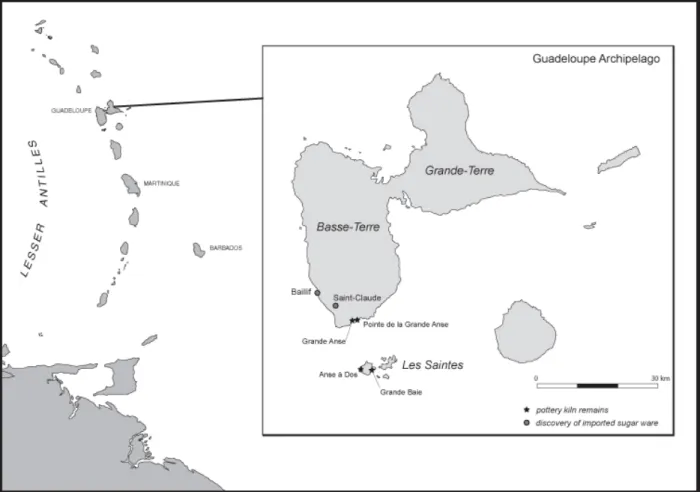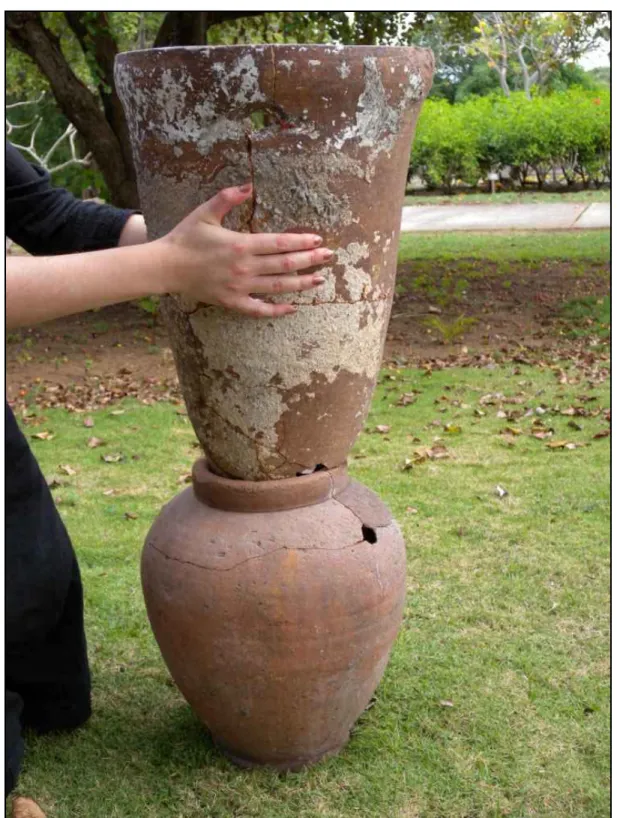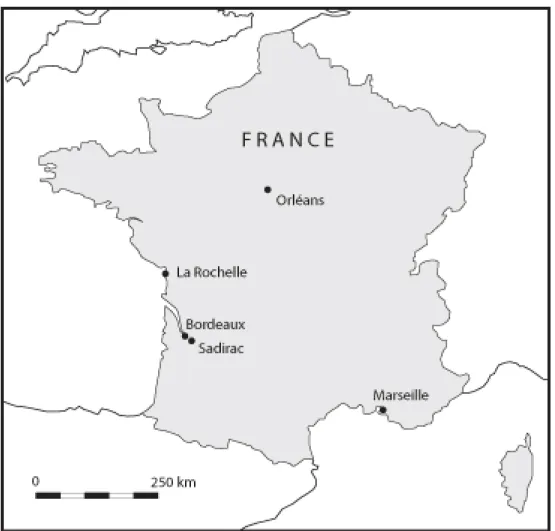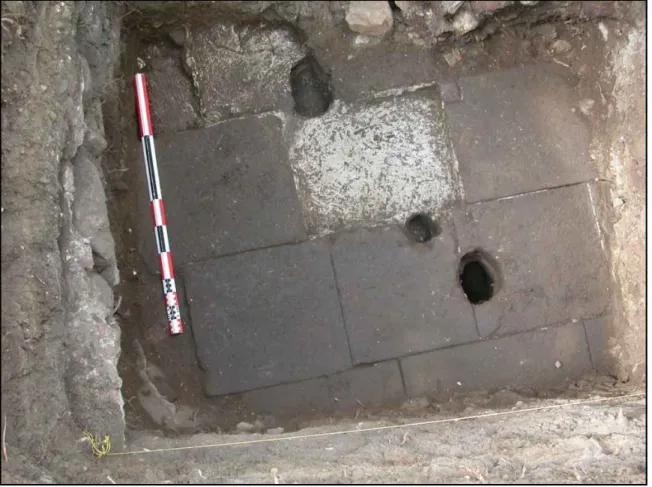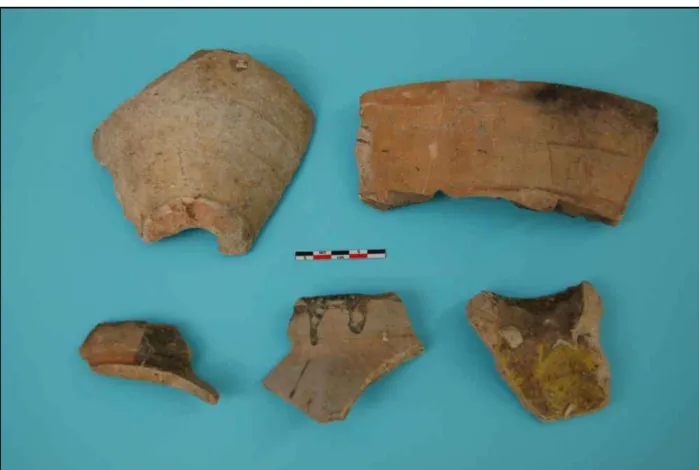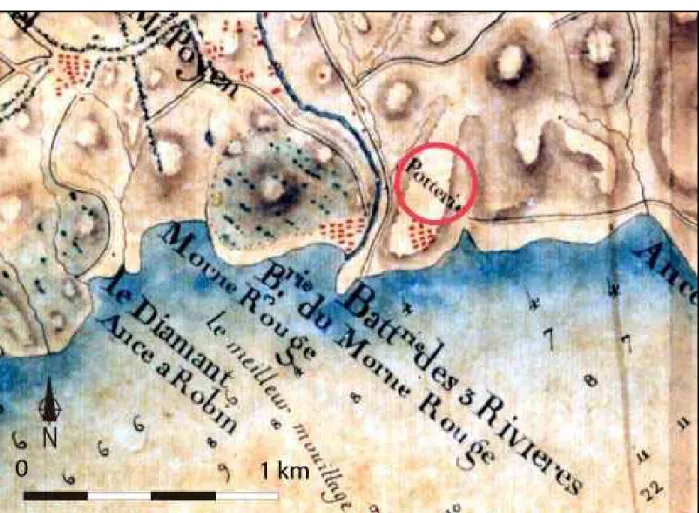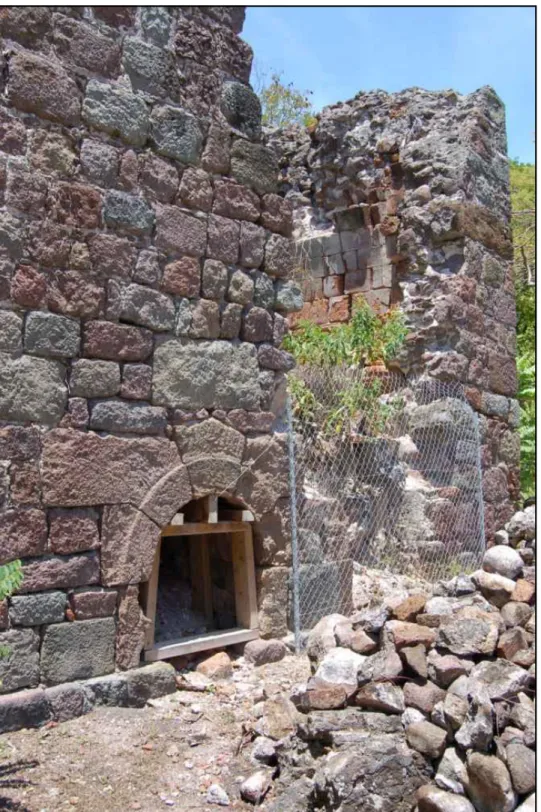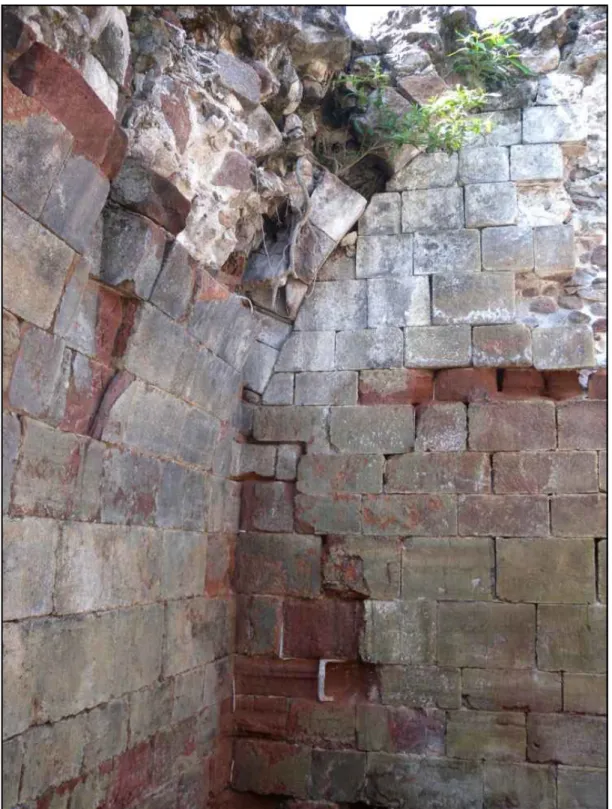HAL Id: hal-01849220
https://hal.archives-ouvertes.fr/hal-01849220
Submitted on 25 Jul 2018HAL is a multi-disciplinary open access archive for the deposit and dissemination of sci-entific research documents, whether they are pub-lished or not. The documents may come from teaching and research institutions in France or abroad, or from public or private research centers.
L’archive ouverte pluridisciplinaire HAL, est destinée au dépôt et à la diffusion de documents scientifiques de niveau recherche, publiés ou non, émanant des établissements d’enseignement et de recherche français ou étrangers, des laboratoires publics ou privés.
indispensable utensils for the sugar industry from the
seventeenth to the nineteenth century
Tristan Yvon
To cite this version:
Tristan Yvon. The provenance of refining pottery in Guadeloupe: indispensable utensils for the sugar industry from the seventeenth to the nineteenth century. Journal of Caribbean Archaeology, Florida Museum/University of Florida, 2011, 11, pp.1-23. �hal-01849220�
ISSN 1524-4776
THE PROVENANCE OF REFINING POTTERY IN GUADELOUPE: INDISPENSABLE UTENSILS FOR THE SUGAR INDUSTRY FROM THE SEVENTEENTH TO THE
NINETEENTH CENTURY
Tristan Yvon
Directorate for Cultural Affairs in Guadeloupe (DAC) Regional Archaeology Service
Associated Researcher at UMR 8096 «Archaeology of the Americas» tristan.yvon@culture.gouv.fr
As in most Caribbean islands, the sugar industry has played a crucial role in the economy of Guadeloupe. From the seventeenth to the nineteenth century, specific ceramic vessels were used to refine the raw sugar to make it fit for consumption. Called sugar cone molds and molasses drip jars, these artifacts are very common in the Guadeloupe archipelago yet they have been little studied. The question of their provenance is essential: it appears that some of these ceram-ics were locally manufactured, and others were imported. This study combines historic docu-ments and the contribution of recent archaeological excavations to address this issue.
Comme dans la plupart des îles des Antilles, l'industrie sucrière a joué un rôle crucial dans l'économie de la Guadeloupe. Du XVIIe au XIXe siècle, des céramiques spécifiques ont été uti-lisées pour raffiner le sucre brut afin de le rendre propre à la consommation. Appelées formes à sucre et pots à mélasse, ces artefacts qui ont été peu étudiés sont très courants dans l'archipel guadeloupéen. La question de leur provenance est essentielle et peut contribuer à la restitution du commerce et des échanges. Cela peut aussi permettre de mieux comprendre l'évolution des structures de production: certaines de ces céramiques ont été fabriquées localement alors que d'autres ont été importées. Il est cependant parfois difficile de distinguer les deux. Le présent article combine à la fois recherches documentaires et données archéologiques récentes pour aborder ces questions.
Como en la mayoría de las islas del Caribe, la industria azucarera ha jugado un rol crucial en la economía de Guadalupe. Desde los siglos XVII al XIX, vasijas cerámicas especiales fueron utilizadas para refinar azúcar para hacerla consumible. Llamados moldes de cono para azú-car y vertedores de melaza, estos artefactos fueron muy comunes en el archipiélago de Guada-lupe pero han sido poco estudiados. La cuestión de su procedencia es crucial: parece que al-gunas de esas cerámicas fueron manufacturadas localmente mientras que otras fueron impor-tadas. El estudio combina documentos históricos y la contribución de excavaciones arqueoló-gicas recientes para abordar reste asunto.
____________________________________________
In the New World, sugar cane cultivation was introduced to Brazil by the Portuguese in the first half of the sixteenth century. The settlement of colonies in the Lesser Antilles
by the French in the first half of the seven-teenth century allowed them to set up their own production sites. The infatuation with sweetened drinks, such as tea, coffee and
chocolate drove a major increase in produc-tion, to the point that between the end of the sixteenth century and the year 1770, world sugar consumption was multiplied by ten, growing from 20,000 to 200,000 tons (Le Bouëdec 1997). Specific ceramic vessels were used to refine raw sugar. The ubiqui-tous presence of these pottery fragments found during archaeological survey or exca-vations carried out throughout the Guade-loupe Archipelago demonstrates the crucial role played by the sugar industry in its econ-omy (Figure 1). Overall this type of artifact has been understudied, although a recent pi-lot work conducted by a team of American researchers deals in part with the
composi-tional analysis of sugar ware from Guade-loupe (Kelly et al. 2008). Samples of ceram-ics produced in the French West Indies were analyzed using INNA and petrographic methods, which was able to yield informa-tion on inter-island trade. However, this work focused on locally-produced sugar ware and therefore presented only one facet of the issue. Indeed a part of these industrial pottery vessels was imported from Metro-politan France.
One essential question to deal with is the provenance of the sugar refining pottery found in Guadeloupe, and its development through time. Integrating historic sources and
archeological data leads to a better under-standing of the nature of these artifacts and the investigation of exciting new research questions.
Context and overview of historic sugar processing
Refining was the process of purifying and whitening sugar obtained from condensation and crystallization of cane juice (called vesou in the French colonies) to make it ready for consumption. Two specific kinds of pottery were required: a tapered container called a sugar cone mold out of which the sugar loaf was extracted, and a jar on top of which the cone mold stood (Figure 2). The drip jars col-lected molasses, a residue from the refining process, which dripped from the bottom of the sugar cone mold. Wooden cone molds were used in the West Indies in the seven-teenth century but they were not as efficient as ceramic molds because the syrup tended to adhere to the inner surface1.
Only a limited number of sugar refineries existed in the French islands, mainly because of the colonial Exclusif introduced by Colbert in 1670: one of its principles lay in the fact that the purpose of the colonies was to pro-vide raw materials to France where they would then be transformed into manufactured products of higher value (such as refined sugar). Sold on the national market or re-exported to other European countries, these products worked towards France's enrich-ment. Driven by the refiners in the metropole, from 1684 the French administration estab-lished a ban on the setting up of any new re-fineries in the Lesser Antilles to ensure that production of refined sugar in the islands would be restricted. In addition, taxes were introduced on refined sugar in order to
dis-courage West Indian producers from refining their own sugar.
However, planters were able to take ad-vantage of an innovative technique called claying, which enabled them to obtain a prod-uct close to refined white sugar in quality, but avoid the restrictions of the exclusif. In this process, clayey soil mixed with water was put on top of the mold, gradually releasing its water and dragging out impurities in the proc-ess. Production of this type of clayed sugar (also called white cassonade) required, in a similar fashion to refined sugar, the use of molds and molasses jars. This was not the case however for raw sugar (called musco-vado) because when removed from the last open kettle, once the syrup had cooled down, it was then poured into drilled barrels through which it dripped while retaining the sugar crystals (Duhamel du Monceau 1781; Labat 1979). The unrefined sugar thus obtained was exported in those same containers.
Taking into account the greater added value of clayed sugar over unrefined sugar, its development would have been a consider-able advantage in the islands during the eight-eenth century. Production of this type of sugar resulted in very high demand for sugar ware from industrial potteries: at the end of the eighteenth century, each sugar plantation in Guadeloupe owned an average of 2,000 to 3,000 molds and drip jars (Parisis 1993). Fur-ther emphasizing the numbers of vessels, in 1775 for instance, there were 454 sugar plan-tations in Guadeloupe and 437 in the rest of the Archipelago (Schnakenbourg 1977).
The term “refinery pottery” is slightly re-strictive because molds and molasses jars were used more for claying than for refining. True refining was a process more complex
Figure 2. Locally-produced sugar cone and drip jar from Guadeloupe (Edgard Clerc Museum collection - Guadeloupe).
than claying in that it required clarifying the sugar in an open kettle while adding lime wa-ter and eggs2, then filtering the produced syrup and finally baking. This being said, claying could be considered as a basic refin-ing process because its purpose was to elimi-nate some impurities out of the unrefined sugar in order to whiten it.
Problems in distinguishing local from imported sugar ware.
Clays in Guadeloupe have rather high iron content (between 3 and 9%), which give baked clay products very strong red tints. Re-ferring to the studies conducted by the Geo-logical and Mining Research Bureau (BRGM) white-baked or very light-coloured clay has not been encountered in Guadeloupe (Barthélémy et al. 2006). Nonetheless, color is not a reliable attribute for distinguishing local pottery from imported pottery, as will be discussed.
Two main refining pottery production cen-ters have been identified in France: Orleans and Bordeaux (Sadirac), although only the latter has been studied extensively. A chrono-typology drawn up by P. Régaldo Saint-Blancard, permitted the identification of the Sadiracan production . The paste is of light color, sometimes almost white (Régaldo Saint-Blancard 1986).A third refining pottery probably existed in Provence, in the Marseille area (Figure 3). Indeed, from the eighteenth century, many refineries were active in Mar-seille as well as in the nearby Huveaune Val-ley, an important pottery production center which was probably meeting the demand for jars and sugar cone molds. In the brief
docu-ment drawn by the Port of Marseille with the Isles of America from 1735 to 1744 taken
from the archives of the Chamber of
Com-merce, mention is made of the wording sugar
cone mold in the inventory of exported
mer-chandise (Rambert 1959). In 1783, in his book dealing with trade in America, Cham-bon specified that in France sugar cone molds were made “primarily in the Bordeaux, Provence and Languedoc regions”(Chambon 1783).
However, the precise location of the pot-teries in Provence that manufactured these refining pottery wares has yet to be identi-fied. It was not until the nineteenth century that the town of Aubagne was quoted in writ-ten references as a manufacturing location (Roux 1834). Nevertheless, production from the Orleans region and the Huveaune Valley were both of red color, similar to the molds and molasses jars manufactured in Guade-loupe.
Therefore red refining pottery found in Guadeloupe does not necessarily indicate cal production, and makes differentiating lo-cal versus non lolo-cal production problematic . It is not impossible that some molds and jars imported from Orleans or Marseille are erro-neously attributed to local production on the basis of color. This could explain why, to date, there are no examples that have been formally identified as coming from Provence in spite of the repeated excavation operations carried out throughout the Archipelago on sites dating to the seventeenth, eighteenth, and nineteenth centuries.
It is obvious that the color of the fired clays is not the only criteria used to charac-terize a refining pottery production; some ty-pological differences exist, yet they have not been clearly identified because of the lack of studies on that subject. It is worth noting that the development of salvage archeology in
Guadeloupe and Martinique has enabled the collection of data that will allow better knowledge of locally-produced refining pot-teries. For example, an archaeological survey evaluation conducted by INRAP in 2007 on the pottery production site of “Petite Poterie” in Martinique was able to show a chrono-typological variation in drip jar production: non-footed jars were replaced by ring-footed jar before the early nineteenth century (Casagrande 2007). Maybe this represents a technical improvement, but for the moment there is no way of telling whether this was common to all the pottery workshops of Mar-tinique and the Guadeloupe Archipelago.
In Metropolitan France, some urban rescue excavations carried out in the major sugar-refining centers as La Rochelle and Marseille have provided a large collection of sugar ware, but this has not yet been analyzed in any detailed or systematic fashion.
The multiplication of physic-chemical and petrographical analyses of local but also met-ropolitan sugar ware could help to distinguish them too. Such a study has recently been ini-tiated by a team of researchers who work on ceramics excavated in the Poitou-Charentes region (Zélie et al. 2010).
Another difficulty which may arise is due to the fact that in the second quarter of the nineteenth century, many secondary pottery production centers in France began to pro-duce sugar ware. Pottery was propro-duced in Saint-Omer (Annales de la société académi-que de Nantes 1830), Angers (Bulletin de la société industrielle d'Angers 1833), Crique-boeuf (Annuaires des cinq départements de l'ancienne Normandie 1850) and Honfleur in Normandy (Thomas 1840), and in Songeons (Hugo 1835) and Saint-Samson in the Oise region (Dupin 1827). A large part of their production probably existed to meet the de-mand of the emerging beet root sugar indus-try. The refining phase was at that time simi-lar for beet root and cane sugar. These prod-ucts may have been exported to the Lesser Antilles for a short period of time. Again, their characteristics are unknown, which does not allow to distinguish them.
Imported sugar ware in Guadeloupe
The changing provenance
Father Labat, a Dominican Missionary who resided in Martinique and Guadeloupe from 1694 to 1706, described in his book en-titled “New Voyage to the French Islands of America” (Nouveau Voyage aux isles
Fran-çoises de l'Amérique) the sugar
manufactur-ing process, as well as the infrastructures and the necessary utensils used. He compared the refining pottery manufactured in the French Antilles to those produced in Bordeaux:
The molds manufactured in the Isles are of a red color, when they are nicely worked they are of rather even and smooth texture although never as much as the ones from Bordeaux. This is more due to the soil than to the work-ers and does not prejudice the sugar placed
inside, which does not affect the way it is worked and how smooth it is. I used to know some skilled refiners who believe they are worth more than the ones from Bordeaux. The ordinary shapes manufactured in the Islands are twenty-six inches high and one foot wide but there are few of that kind, because ordi-nary ones are big enough to be used in a simi-lar fashion the hybrids are.
The jars put under the molds to hold them and catch the syrup dripping out of them are proportionate to the molds they have to bear. Generally speaking, the Bordeaux ones are too small and are only good for the refineries in the Islands where they are whitened; larger quantities require larger vessels to be con-tained in.
The jars, to be well manufactured, must have the bottom or the plate wide and plain, and the top of the jar, also called neck, strengthened properly. One has to avoid put-ting some feet, like the Bordeaux ones have, because these feet are ornamental and can eas-ily break away, thus making the jar useless.
The ones manufactured in the Islands are fifteen or sixteen inches high; the diameter of their mouth is four and a half inches wide or thereabouts ; the bottom is twice as large and the gut is fifteen or sixteen inches.
The price of the jars and the molds is fixed depending on the demand, or rather the abun-dance or the shortage trends in the islands.
Ordinarily speaking, the jar and the mold in the Country are sold a three pound crown, taken from the place where they are made (Labat 1979 [1722]:III:287-289).
It is worth stating that Father Labat com-pared the pottery works made in the islands to those coming from Bordeaux, and not the other famous big production center in
Or-leans, or the one supposedly located in Mar-seilles Moreover, the site in Baillif, in the contemporary sources only delivered Bor-deaux pottery works (Sadirac), which sug-gests that this production site was the main supplier of imported refining pottery for Gua-deloupe and Martinique at the end of the sev-enteenth century.
The majority of the refining pottery from Sadirac exported to the Lesser Antilles were probably shipped from the port of Bordeaux, although some may have transited via the La Rochelle port which under the Colbert Minis-try was the most important trade port with the West Indies. In a 1674 cargo list of the
Angé-lique, leaving from the La Rochelle Port,
there is mention of 1,800 jars and molds des-tined to the “Guadeloupe refin-ery” (Plissonneau-Duquêne 1935).
A recent salvage excavation carried out in the center of La Rochelle, close to the quays, recovered refining pottery, some of which is attributable to the Sadirac workshops.5 These were associated with the remains of a refinery which supposedly existed from the second half of the eighteenth century; this confirms that this pottery production center was sup-plying at least part of the town at that time (Zélie 2008). However the provenance of a part of the refining pottery discovered is still non identified, illustrating the insufficient knowledge of this type of artifact.
A document kept at the French Historical Archives illustrates the challenge of supply-ing sufficient refinsupply-ing pottery to sugar refin-eries in France:6 in the first quarter of the eighteenth century, the refiners of Bordeaux used an ordinance forbidding the purchase of cone molds and molasses jars manufactured in Sadirac and places adjoining Bordeaux by
refiners from La Rochelle, in order to ensure adequate supplies of scarce refining pottery for Bordeaux. The refiners of La Rochelle denied responsibility for this shortage and claimed that they were victims themselves. According to them, the reason is more likely to be found in the “tremendous amounts” then being exported to America.
Father Du Tertre, a Dominican, resided in Guadeloupe and Martinique from 1640 to 1648 before going back to France. He also returned to the Lesser Antilles for a few months in 1656. Around 1660 he published a book entitled “The General History of the Antilles inhabited by the French” (l'Histoire
générale des Antilles habitées par les Fran-çais). Writing before Father Labat, he
indi-cates a place other than the Bordeaux region as the place of origin of imported refining potteries. According to Du Tertre, before 1654 the refining pottery used by the settlers were imported from Holland “at great cost” (Du Tertre 1978 [1667 & 1671]). In 1654, Dutch planters forced out of Brazil ar-rived in Guadeloupe. They supposedly came with some slaves, “one of whom who knew how to make molds”. It was through this in-termediary that the French settlers probably learned how to make the sugar cone molds, thus putting an end to imports from Holland.
Are Du Tertre’s claims credible? From a technological point of view, it is true that the sugar cone molds were refining pottery with very specific characteristics, unlike molasses jars which were close to culinary pottery. This directly impacts the manufacturing tech-nology. For example, Regaldo-Saint-Blancard proved the use of a core-mold for the sugar cones produced in Sadirac (Régaldo Saint-Blancard 1986). In order to make sugar cone molds, then, it was thus necessary, even
for an experienced potter, to learn the tech-nique. Du Tertre's account is therefore credi-ble on that point.
With regards to importation of molds from Holland to Guadeloupe, several remarks ought to be made. It is worth wondering why in the middle of the seventeenth century the sugar cone molds would not have been im-ported from France via La Rochelle or Bor-deaux, as this was the case from the second half of the seventeenth century. It should be noted that the making of refining pottery in France by pottery workshops was often re-lated to the presence of refineries nearby. As from the sixteenth century, some refineries operated in La Rochelle to process the unre-fined sugar coming from the Portuguese colo-nies, and they were supplied with pottery by some regional workshops, as demonstrated by J. Chapelot (2005). However, in the mid-dle of the seventeenth century the situation seems to have changed: Delafosse found for La Rochelle only one mention of a refinery, “rather doubtful” at that, and the sugar still arriving from Portugal was white sugar (Delafosse 1949). It is therefore possible that at that period, the sugar cone mold had disap-peared from the catalogue of the potters' workshops which were supplying the refiner-ies in the town during the previous century, and that this market had been taken over, in the second half of the seventeenth century, by the Sadirac workshop when refining had started again. The most ancient refining pot-tery found during the excavation of kilns in that workshop dated from that period (Régaldo Saint-Blancard 1986) and in 1672, at least five refineries were in activity in La Rochelle (Delafosse 1949).
In addition, it is worth noting that by 1670 the Dutch were practically wiped out of the
West Indies trade as a result of the protec-tionist policy led by Colbert. Before that date, they augmented the insufficient French fleet. The Dutch made great profit from trading with the islands, bringing them products of all kinds. Export to Guadeloupe by the Dutch, during the mid seventeenth century, of sugar cone molds used in large numbers in their numerous refineries in Amsterdam or Flem-ing is plausible, particularly as the Dutch re-fineries were partly supplied with unrefined sugar coming from the West Indies brought back to Holland by the Dutch fleet.
However, another hypothesis remains pos-sible: Du Tertre could have had knowledge himself or even had seen some refining pot-tery brought in by some Dutch ships unloaded in Guadeloupe and simply jumped to the conclusion that these originated from Holland, although these could have been made in any of their own West Indian colo-nies of that time (Aruba, Curaçao, Bonaire, Sint Marteen, Sint Eustatius).
Archeological data from Guadeloupe
Several archeological surveys made in the town of Baillif (Guadeloupe) in the last dec-ade permitted to discover a new type of sugar ware thus far unknown in the Archipelago. Baillif was founded in the middle of the sev-enteenth century, and destroyed and aban-doned in 1703 after an attack by the British. The excavations done on that site are located in a zone, which according to the ancient plans available, refers to a commercial zone of warehouses owned by the West Indies Company and some planters as well(Yvon 2011). The last excavation undertaken in 2006 enabled the identification of a paving of volcanic stones on which rested a huge amount of molasses jar and sugar cone mold
fragments which had been damaged by fire, at the same period the site was abandoned (Yvon 2008) (Figure 4). It is likely that these are remains of a warehouse in which some pottery had been put in storage destined to be sent to sugar plantations in the area or an-other refinery. In fact, Father Labat, who lived in Baillif at the very beginning of the eighteenth century, mentions the ruins of a building set on fire by the British, in between which there also was, he thought “a very nice refinery” (Labat 1979). The various excava-tions carried out did not permit the definitive identification of the buildings destroyed. Nevertheless, these were buildings with an industrial or commercial purpose, because
refining pottery represents the majority of materials recovered (Bigot 2005).
The inside of the molasses jars recovered display a green olive glaze which serves as a sealant (Figure 5). It is worth noting that it seems that no glazed refining pottery had ever been made in Guadeloupe or Martin-ique: the pottery workshops where excava-tions or collecexcava-tions were carried out only yielded unglazed pottery (Gabriel 2004; Kelly et al. 2008). This fact is corroborated in at least one written source. Indeed, Jean-Baptiste Mathieu Thibault de Chanvallon, who resided in Martinique from 1751 to 1756, stated that they were imported from France:
Figure 4. Paving of volcanic stones excavated in Baillif (year 2006) on which a lot of drip jar and sugar cone fragments from Sadirac were discovered. One meter rod.
“…all these small varnished clay vases and utensils that the population uses ; in the Isles, they don't know how to varnish3 them”. (Chanvallon 2004 [1763]:58).
The glaze and the type of paste observed as well as the presence of ear-shaped feet on certain molasses jars discovered in the Baillif area indicate that this production originated from the Bordeaux region, according to the typology drawn by Régaldo Saint-Blancard (Régaldo Saint-Blancard 1986) (Figure 6). The sugar cone molds associated with the molasses jars display the same type of paste, however, their inside is free from any glaze. No molasses jars with ear-shaped feet were found in the wasters of the kilns remains in
Guadeloupe. Only non-footed or ring-footed jars were discovered. It confirms the story of Father Labat (see above).
A second series of refining pottery from Bordeaux (Sadirac) has recently been discov-ered in Guadeloupe during the course of an archaeological assessment on the future site of the Cité de la Connaissance in Saint-Claude (Basse-Terre) 4. The glaze and the type of paste are similar to those of sugar ware discovered in Baillif. As this article is being written, the study is being carried out. The remains are likely to be those of a sugar plantation founded in the third quarter of the seventeenth century, which became the prop-erty of the Godet-Desmarais family from 1710 (Parisis 1994 to 1998).
Figure 5. Sherds of sugar-refining pottery produced in Sadirac, excavated from Baillif, Guadeloupe, 2006. Scale is 5 cm long
Figure 6. Drip jar and sugar cone from Sadirac excavated from Baillif, Guadeloupe, 2006 (drawn by F. Bigot). Shading denotes glaze.
Production, trade and exchange of local sugar ware
According to Father Du Tertre, from 1654, the settlers started to manufacture molds for sugar refining in Guadeloupe that replaced the Dutch molds. Father Labat's account, which was written at a later time, argued in the same sense:
“There are in Martinique and Guadeloupe, some pottery workshops where the jars and the molds are manufactured to make white sugar” (Labat 1979 [1722]:II:95).
The sugar plantation of the White Fathers in the town of Baillif, where Father Labat had lived, had its own pottery workshop which made “jars and molds to whiten sugar, tiles or squares” depending on the needs (Labat 1979 [1722]:95). Exports to Martinique by boat even occurred to supply the Fonds
Saint-Jacques plantation in Sainte-Marie, also
be-longing to the Dominican Order to which Fa-ther Labat was affiliated (Labat 1979 [1722]:74).
It would seem that this pottery workshop would have been created initially to meet the needs of the sugar plantations belonging to religious orders rather than for commercial purposes stricto sensu, although the trade of pottery to other plantations rapidly became a non-negligible source of income with the growth of the sugar industry. When the Brit-ish landed in south Basse-Terre in 1703, they destroyed and burned down the towns they passed through as well as a large number of plantations including that of the Dominicans in Baillif. Once peace returned, the Domini-cans rushed to rebuild the pottery workshop, because the British expressly destroyed all
the molasses jars and the sugar cane molds they came across, and the Dominicans were aware that demand was going to be high and profits very likely (Labat 1979 [1722]:308).
It probably was not fortuitous that one of the first pottery workshops mentioned in Guadeloupe belonged to a religious order, which was likely to have had a greater finan-cial investment capacity than many plantation owners. The recent studies conducted on the Loyola plantation in Guyana, owned by the Jesuits, founded in the mid seventeenth ctury showed that their significant capital en-abled them to build a pottery workshop des-tined to supply refining pottery to their sugar plantation as well as the neighboring planta-tions (Croteau 2004).
Nonetheless, the discovery of refining pot-teries from France in the ancient town of Baillif suggest that the local pottery work-shops were unable to cover the demand at the end of the seventeenth century. Imported ware induces high transport costs and a risk of breakage. Du Tertre had already men-tioned a lack of potters in spite of the pres-ence of good clay for the manufacture of bricks, tiles and potteries (Du Tertre 1978 [1667 & 1671]:72). About twenty years later, this question had not yet been resolved if we are to refer to a letter written by Colbert dated 8th December 1670 for the attention of the Director of the West Indies Company:
I am pleased to know that in the islands, it is possible to encounter some soil proper for the manufacture of moulds for sugar refining; I gave the order to the Company to designate the three or four terracotta potters you were requesting, considering the fact that there is nothing more which can con-tribute to bring value to the refineries and
provide more usefulness to the inhabitants using them (Clément 1865:502).
It is likely that the terracotta workshops in Guadeloupe were developed mostly during the eighteenth century to meet the growing demand for refining pottery for sugar planta-tions or manufacturing materials required for the economic development of the Archipel-ago (bricks and terracotta tiles). The story is quite similar in Barbados: the ability to make and fire pottery vessels had been introduced between the 1640's and 1678 probably by potters from England, then earthen wares were beginning to supplant wooden contain-ers in the sugar industry. Around 1775, 19 kilns existed in the island (Handler 1963).
On the map of Guadeloupe drafted by French Royal Engineers between 1764 and 1768, several pottery or brickworks sites were listed (Figure 7). The evolution of the number of pottery workshops in Guadeloupe between 1748 and 1835 is partially known thanks to the works of C. Schnakenbourg (Table 1).
The development of the pottery production capacity in the Archipelago theoretically must have considerably reduced the import of sugar cone molds and molasses jars from France. This could explain why the only sig-nificant sugar ware collections from Sadirac excavated in Guadeloupe came from two sites of the second half of the seventeenth century, both located in Basse-Terre, and that in spite of an number of excavations or ar-chaeological prospective searches carried on sites dating from colonial times in
Grande-Terre (only occupied from the first quarter of the eighteenth century), no similar collection was discovered.
The remains of four pottery kilns are still in the Archipelago, in southern Basse-Terre and Les Saintes (see Figure 1). Two of these were recently subjected to test excavations, which allowed the study of the production (Van Den Bel 2007; Gabriel 2004). These are the Pointe de la Grande Anse pottery work-shop in Trois-Rivières created after 1735, and the Fidelin pottery workshop at Grande Baie on the island ofTerrede Bas founded around 1760 (Figures 8 and 9). An archeological building analysis of the Fidelin workshop was conducted in 2008 and 2009 (Amouric 2008 & 2009). There are many buildings as a double-chamber kiln, a storehouse, a clay mill, a cistern.
The building remains of the second pottery workshop of Terre-de-Bas at Anse à Dos are much less well preserved. However the clay source used for making pottery is clearly visi-ble on this site. The clay has a light grey color and seems very pure. It would be inter-esting to analyze it.
It is important to point out that some of these pottery workshops may have been able to export their production to other Caribbean islands. During 1755 for instance, two ships from Guadeloupe sailed away to Santo Do-mingo with a sizable cargo of jars and sugar cone molds, 8,600 in total.7 These exchanges come within the framework of a triangular and intercolonial trade: after the unloading of their pottery cargo, the first ship loaded Year 1748 1749 1752 1753 1785 1788 1790 1828 1835
Number 7 8 9 9 3 7 6 1 1 Table 1. Number of pottery workshops in Guadeloupe between 1748 and 1835
ISSN 1524-4776
freight in Santo Domingo to take to France while the second returned to the harbor of Louisbourg in Isle Royale (today Cape Breton Island) in North America. This last example illustrates the trade between Louis-bourg and the West Indies which developed as early as 1720. In exchange for tropical products, Louisbourg supplied the Windward Islands with dried cod to feed their increasing slave population (Havard & Vidal 2003). This ship, after having delivered its jars and sugar cone molds in Santo Domingo, proba-bly loaded goods intended for unloading in Louisbourg, before setting off again to Gua-deloupe with a cargo of dried cod.
This intercolonial trade involving Guade-loupe and its pottery production is not an iso-lated example because in 1733 a ship left from Saint Pierre in Martinique to Santo Do-mingo, with another cargo of refining pot-tery8 .
Although long distance maritime trade has been well studied, some important gaps re-main to be filled pertaining to coastal naviga-tion and trade (or cabotage), namely in be-tween islands. Contraband trade was all the more important in a region where islands are of volcanic origin with steep relief, and Figure 7. Extract of the Guadeloupe Map drafted by French Royal Engineers between 1764 and 1768, on which a pottery workshop is located at Trois-Rivières (archival document from Service Historique de la
ISSN 1524-4776
Figure 8. Pottery kiln remains at Grande Baie, Terre-de-Bas, Les Saintes, Guadeloupe, 2009.
ISSN 1524-4776
Figure 9. Interior of the kiln chamber at Grande Baie, Terre-de-Bas, Les Saintes, Guadeloupe, 2009.
ISSN 1524-4776
where for a very long time, the sea was the main transportation means. The local pottery production, as for many products, was dis-tributed through this means. The underwater presence of some sugar cone molds still stacked together near Anse Cafard in Martin-ique illustrates that there was a shipwreck of a coaster shipment there (GRAN 2000). The compositional analysis of archeological ce-ramics conducted by Kelly et al. have illus-trated inter-island trade between Martinique and Guadeloupe: hand-built ceramics found in Guadeloupe were probably made in Mar-tinique (Kelly et al. 2008). Archival data prove that this trade may have also been con-cerned with industrial pottery vessels: in 1806, a ship of 29 tons sailed away from Saint-Pierre in Martinique to Point-à-Pitre in Guadeloupe with a cargo of drip jars and sugar cones.9
Even though refining pottery imported from France must have become proportion-ally limited during the eighteenth century, it did not disappear completely if we acknowl-edge the following source: in 1787, owners of the Bologne sugar plantation in the town of Baillif entrusted the administration to a per-son called Clairefontaine, who himself in turn transferred his powers to a trader from Nantes. This trader received sugar and coffee from Guadeloupe to sell them at the best rate and send equipment in return from France to the plantation: mills spares, sugar cone molds, garments to dress the slaves, salt meat and fish, flour and dried foods (Debien 1965). It is to be noted that Bordeaux supplied Nantes and La Rochelle with refining pottery (Durand). The administration of this planta-tion was, in other words, absentee, and the owners were in actual fact only income re-ceivers. The administrator only bought
emer-gency produce locally. In this specific case, refining pottery only seems to reflect the type of administration of the plantation and not necessarily a deficit in sugar cone molds and molasses jars available on the local market. It still remains to determine whether this type of administration was atypical or not in Guade-loupe.
We have to refrain from drawing a simpli-fied understanding of commercial trade linked to this pottery production because re-fining pottery had been produced at quite an early stage in Guadeloupe and imports from France also took place at the same time. As illustrated by Father Labat in his works, some trade also occurred between Guadeloupe and Martinique; these islands were also able to export part of their production to other Carib-bean islands punctually. In the same instance, they probably received refining pottery from neighboring islands.
During the nineteenth century, competi-tion from the beet root sugar industry in Europe and the workforce shortage due to the end of the slave system required moderniza-tion of the producmoderniza-tion system: sugar planta-tions which were no longer profitable were gradually replaced by central factories pro-ducing at lower cost a superior quality of sugar. The sugar manufacturing method taken from Father Labat was then replaced by a system where evaporation and crystallization took place in vacuum pans and most of all where separation of sugar from the syrup was made thanks to centrifugal turbines: this forced drainage purified the sugar within a few minutes, unlike that done by refining pot-tery which took fifteen days. In parallel, the use of steel-painted molds spread widely from 1840 and all but rendered refining
pot-ISSN 1524-4776
tery obsolete Drilled wooden chests used to receive the molds also made molasses jars obsolete in the same period (Fierain 1976).
These changes resulted in the decline and disappearance of many pottery workshops in Guadeloupe, even though some sites like the Fidelin pottery workshop in Terre-de-Bas were able to subsist for several decades to come, orienting their production to domestic wares as cooking and serving vessels and pitchers (Gabriel 2004).
Conclusion
As observed, many questions still remain unanswered, both about the refining pottery itself and about its provenance and distribu-tion. As an archaeological study, this produc-tion has been by and large under-exploited. However, knowing that they were used for nearly two centuries, one can easily get a feel for their potential. Additionally, besides the fact that the study of the evolution of pottery production is intrinsically linked to the sugar industry, this type of artifact can prove to be a precious chronological marker for the ar-chaeologist because of its omnipresence in the Archipelago and the period of time it was used for.
The development of salvage archaeology in Guadeloupe and Martinique has enabled the collection of data that will allow better knowledge of locally-produced refining pot-teries. In Metropolitan France, some rescue excavations carried out in many sugar refin-ing centers discovered significant collections of refining potteries in a stratified context. It was to be hoped that their study would offer the opportunity to establish the chrono-typologies that are lacking today. It will
con-tribute to distinguishing imported from local sugar ware in Guadeloupe.
INNA and petrographic methods, as used by Kelly et al. to analyze ceramics, could help to establish the provenance of refining potteries productions and allow better knowl-edge of trade and exchange between Metro-politan France and its overseas colonies, but between west indian colonies too.
However, it is preferable that this type of work be combined with the historical sources and an archival research, otherwise there is a risk of pushing at an open door. It is particu-larly important to use this essential source of information for historical archeology. More-over, historical and archival research could help to identify more relevant issues to con-duct analysis. As archival data we collected proved, pottery workshops of Guadeloupe and Martinique exported a part of their pro-duction to Saint-Domingue, and probably to other places in west indies. It opens up new prospects for research.
Notes
1
In the third quarter of the 17th Century the Beausoleil sugar plantation in Saint Claude (Guadeloupe), property of the Carmes had two hundred mahogany moulds at its dis-posal, this tree species points to the fact that they quite likely have a local origin (Lafleur 1993). In Barbados, in the late 1640's, wood and not clay was being used by the sugar in-dustry for the Muscovado containers
(Handlers 1963). 2
From the beginning of the 18th Century, some refiners replaced the eggs with steer blood despite the distrust of the authorities
ISSN 1524-4776
who feared for the consumers’ health, CA-RAN, sugar manufacturing 1708-1778, F121501.
3
Nowadays the term “varnish”denotes a type of glaze but in french language, in the eight-eenth century, the term “glaçure”(glaze) did-n't exist yet. “Varnish” was the general term used.
4
F. Casagrande, French National Institute of Preventive Archeology (INRAP), archeologi-cal evaluation, Saint-Claude, october 2008. 5
B. Zélie (éveha), excavation of 23 Duke's street, La Rochelle, 2008.
6
CARAN, sugar manufacturing 1708-1778, F121501, The refiners from La Rochelle, tradictorily with refiners from Bordeaux con-cerning pottery workshops suited to the refin-ing of sugar. 7 ANOM, C7A17, fol.162. 8 ANOM, C8B17 (ADM, 1 mi 1445). 9 ANOM, C8B27. Archival Sources
Archives Nationales d'Outre-mer, Aix-en-Provence (ANOM)
- Collection Moreau de Saint-Méry F3161, fol.75.
- Correspondances à l'arrivée Guadeloupe C7A17, fol.162.
-Correspondances à l'arrivée Martinique C8B17 (ADM, 1 mi 1445).
C8B27.
Centre d'Accueil et de Recherche des Archi-ves Nationales, Paris (CARAN)
- Commerce et industrie
F121501, manufactures sucres 1708-1778.
References Cited
Amouric (H.) (under the direction of)
2008, Rapport d'activité 2008 du Projet
Collectif de Recherche « Poterie des îles françaises de l'Amérique : produc-tions locales et importées, XVIIe-XIXe siècles », unpublished report.
2009, Rapport d'activité 2009 du Projet
Collectif de Recherche « Poterie des îles françaises de l'Amérique : produc-tions locales et importées, XVIIe-XIXe siècles », unpublished report.
Association normande
1850 Annuaires des cinq départements de
l'ancienne Normandie. Caen.
Barthelemy (F.), Bes de Berc (S.), Husson (Y)
2006, Argiles de la Guadeloupe:
inventai-re, caractérisation et usages, report
BRGM/RP – 54 917 – FR. Bigot, Franck
2005, Le matériel céramique du site de
l’Embouchure de Baillif, , unpublished
report No. 307 from regional archaeolo-gy service of Guadeloupe.
Casagrande, Fabrice
2007, Diagnostic archéologique de la « Petite Poterie » (Le Marin, Martin-ique), INRAP, unpublished report.
ISSN 1524-4776
Chambon
1783 Traité général du commerce de
l'Amérique. Tome I, Marc-Michel Rey,
Jean Mossy, Amsterdam-Marseilles. Chanvallon, Jean-Baptiste Thibault de
2004 [1763] Voyage à la Martinique,
contenant diverses Observations sur la Physique, l'Histoire Naturelle, l'Agri-culture, les Mœurs, & les Usages de cette Isle. Karthala, Paris.
Chapelot, Jean
2005 Le raffinage du sucre dans la se-conde moitié du XVIème siècle à La Rochelle et ses relations avec les ate-liers céramiques régionaux. In
Archéo-logie médiévale 35:167-173.
Clément, Pierre
1865 Lettre instructions et mémoires de
Colbert, Vol. III. Imprimerie Impériale, Paris.
Croteau, Nathalie
2004 L’habitation de 2004 Loyola: un rare exemple de prospérité en Guyane française. In Historical Archaeology in
the French Caribbean, edited by
Ken-neth Kelly. Journal of Caribbean
Ar-chaeology, Special Publication 2:68-80.
Debien, Gabriel
1965 La caféière et la sucrerie Bologne au Baillif (1787), In Bulletin de la société
d’histoire de la Guadeloupe 3:11-21.
Delafosse, Marcel
1949 La Rochelle et les Iles au XVIIème siècle. In Revue d'Histoire des
colo-nies, Vol. XXXVI., Société de l'Histoire
des colonies françaises, pp. 238-281. Paris.
Duhamel Du Monceau, Henri-Louis
1781 L'art de raffiner le sucre. In
Descrip-tions des arts et métiers, faites ou ap-prouvées par Messieurs de l'Académie royale des sciences de Paris, Vol. XV,
Neuchâtel: J.-E Bertrand, pp. 467-550. Originally published 1761, Saillant et Noyon, Paris.
Dupin, Charles
1827 Forces productives et commerciales
de la France. Bachelier, Paris.
Durand, Pierre
n.d. Archéologie industrielle, formes à sucre. Manuscript from regional ar-chaeology service of Guadeloupe no. 52 30 050, year of publication unknown. Du Tertre, Jean-Baptiste
1978 [1667 & 1671] Histoire générale des
Antilles habitées par les François, 4
vols. Kolodzieg, Paris. Fierain, Jacques
1976 Les raffineries de sucre en France
(XIXème – début XIXème siècle). Ph.D.
dissertation, University of Nantes, pu-blished by Lille III University Press. Gabrielle, Isabelle
2004 Rapport sur le mobilier de
l’habita-tion-poterie Fidelin, Terre-de-Bas (archipel des Saintes) provenant de la première campagne de fouilles pro-grammées 2002, unpublished report No.
330 from regional archaeology service of Guadeloupe.
GRAN, Groupe de Recherche en Archéologie Navale
2000 Liste des sites archéologiques
do-ISSN 1524-4776
cument, http://www.archeonavale.org/ martinique/pages/listsite.html.
Handler, Jerome S.,
1963 A historical sketch of pottery manu-facture in Barbados. In Journal of the
Barbados Mus. and Hist. Soc., 30
:129-53.
Havard, Gilles & Vidal, Cécile
2003 Histoire de l'Amérique française. Flammarion, Mayenne.
Hugo, Abel
1835 France pittoresque ou description
pittoresque, topographique et statisti-que des départements et colonies de la France, Vol. II. Delloye, Paris.
Kelly, Kenneth G., Mark W. Hauser, Christo-phe Descantes and Michael D. Glascock
2008 Compositional Analysis of French Colonial Ceramics. In Journal of
Car-ibbean Archaeology, Special
publica-tion number 2. Labat, Jean-Baptiste
1979 [1722] Nouveau Voyage aux Isles de
l’Amérique. 5 vols. Courtinard,
Martini-que. Lafleur, Gérard
1993 Saint-Claude, Histoire d'une
com-mune de Guadeloupe. Karthala.
Le Bouëdec, Gérard
1997 Activités maritimes et sociétés
litto-rales de l’Europe atlantique 1690-1790,
Armand Colin. Parisis, Denise & Henri
1993 Poterie de Terre-de-Bas, Groupe de recherche en archéologie industrielle,
University of the French West Indies and Guiana, unpublished report.
1994 to 1998 Etude des sites de la
com-mune de Saint-Claude, Groupe de
re-cherche en archéologie industrielle, University of the French West Indies and Guiana, unpublished report.
Plissonneau-Duquêne, René
1935 Un essai de contingentement
d'im-portation au XVIIème siècle (Episode de la lutte entre raffineries coloniales et métropolitaines), Librairie du Recueil
Sirey, Paris. Rambert, Gaston
1959 Histoire du commerce de Marseille:
de 1660 à 1789. Les colonies. Plon,
Pa-ris.
Regaldo-Saint-Blancard, Pierre
1990 Contribution à l’étude des
cérami-ques d’origine archéologique de la Martinique, IV Note sur un fragment de lèvre de moule à pains de sucre,
CRIAA/CERA, pp. 1-3.
1986 Les céramiques de raffinage du su-cre: typologie, technologie. In
Archéo-logie du midi médiéval 4:151-168.
Roux, Pierre-Martin
1834 Répertoire des travaux de la société
de statistique de Marseille, Vol. XVII,
pp.378-379. Marseille. Schnakenbourg, Christian
1969 Notes sur les origines de l'industrie sucrière en Guadeloupe au XVIIème siècle (1640-1670), In Revue française
So-ISSN 1524-4776
ciété Française d'Histoire d'Outre-Mer, Paris, pp. 267-315.
1977 Statistiques pour l'histoire de l'éco-nomie de plantation en Guadeloupe et Martinique (1635-1835) . In Bulletin de
la société d'Histoire de la Guadeloupe
No. 31.
Société académique du département de la Loire Inférieure
1830 Annales Vol. I. Nantes.
Société industrielle d'Angers et du départe-ment de Maine et Loire
1833 Bulletin No. 1. Angers. Thomas, Pierre Philippe Urbain
1840 Histoire de la ville de Honfleur. E. Dupray, Honfleur.
Van Den Bel, Martijn
2007 Rapport de diagnostic, Grande Anse,
parcelle AT 972, unpublished report
No. 351 of archaeological evaluation from regional archaeology service of Guadeloupe.
Yvon, Tristan
2008a Sondage d’urgence rue de la
Made-leine, site de l’ancien bourg de Baillif,
unpublished report from regional ar-chaeology service of Guadeloupe. 2008b Baillif, un des premiers bourgs de
la Guadeloupe: apport de l’archéologie et des sources écrites à la connaissance des réseaux de production et de diffu-sion des céramiques de raffinage du su-cre. Proceedings of the 133th CTHS congress, Québec, in press.
Zélie, Bruno
2008 Fouille du 23 rue du Duc, La Ro-chelle, éveha. In Bilan scientifique de la
région Poitou-Charentes 2008,
Direc-tion régionale des affaires culturelles Poitou-Charentes. Service régional de l'archéologie, Poitiers.
Zélie, Bruno, Mikaël Augeron, Fabienne Chi-ron-Champagne, Eric Normand, Sébastien Pauly,
2010 Les témoignages du sucre à La Ro-chelle. In Résumés des communications
des journées ICERAMM 2010 de Brouage.
h t t p : / / i c e r a m m . u n i v - t o u r s . f r / documents/20110318152412.pdf
